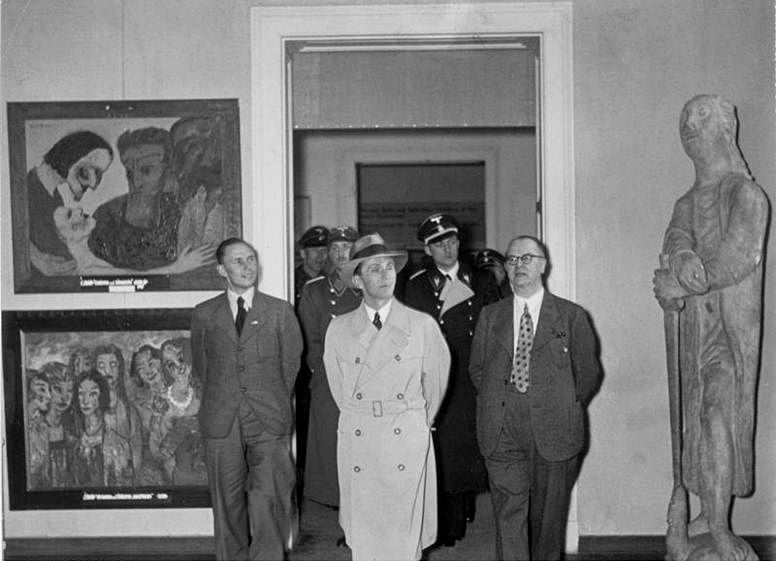How the Brits Refuted Nazi Germany’s ‘Degenerate Art’ Exhibition
The 1938 show celebrated works by German Expressionists, defended artists on world stage
/https://tf-cmsv2-smithsonianmag-media.s3.amazonaws.com/filer/65/e9/65e914e1-b145-4d8b-8c41-669398b70f4d/kandinsky_-_jaune_rouge_bleu.jpg)
Like most European Expressionists, Wassily Kandinsky was entranced by the power of color. His abstract paintings feature a calligraphic style evocative of musical symphonies, further accentuated by violently clashing shades that reveal, in Kandinsky’s own words, “color is the keyboard, the eyes are the harmonies, the soul is the piano with many strings. The artist is the hand that plays, touching one key or another, to cause vibrations in the soul.”
Kandinsky’s embrace of Modernist art landed him a prominent spot in both the Nazis’ 1937 Degenerate Art exhibition, which featured 650 works of art deemed anathema to the regime’s totalitarian values, and a lesser-known 1938 British show, Twentieth Century German Art, staged in direct defiance of Nazi censorship.
London 1938: Defending ‘Degenerate’ German Art, a new exhibition at London’s Wiener Library—a national archive dedicated to the study of the Holocaust and other instances of genocide—tells the story of both shows.
According to The Guardian’s Mark Brown, the British exhibition was held in London’s New Burlington galleries in July 1938. It featured more than 300 works by artists such as Ernest Kirchner and Paul Klee, many of whom had been classified as “degenerate” in the previous year’s exhibition, which had been staged to mock and ridicule the art in it.
Whereas the Nazis’ show labeled these artists’ work as “an insult to German womanhood,” “nature as seen by sick minds” and “revelation[s] of the Jewish racial soul,” the Brits celebrated the Expressionists’ bold paintings. As Brown notes, however, a flyer for the show only obliquely referenced the works’ past, stating, “Much of this art is now in official disfavour in the country of its origin.”
Still, the Wiener Library’s exhibition page describes the show as “an attempt to defend [persecuted] artists and their work on a world stage,” marking the “most prominent international response to the Nazi campaign against ‘degenerate’ art.”
Barbara Warnock, co-curator of the new exhibition, tells Brown that the display aims to highlight the wider context of the 1938 show. For example, Emil Nolde’s "The Young Academic" (1918), a work featured in both the earlier show and the new one, was originally loaned to the New Burlington galleries by Ernst Nelkenstock, a German man of Jewish heritage who immigrated to Britain amidst the uncertainty of the late 1930s.
In addition to featuring two paintings included in the original exhibition—Max Slevogt’s "The Panther" (1931) and Nolde’s "The Young Academic"—the Wiener display incorporates reproductions of works such as Kandinsky’s "Untitled Improvisation II" (1914) and Max Liebermann’s 1925 portrait of Albert Einstein.

Artnet News’ Henri Neuendorf writes that the Nazis’ Degenerate Art exhibition was juxtaposed with a Great German Art exhibition held in Munich. Compared to the “offensive” paintings in the former exhibition, the latter featured pastoral scenes and works painted in classical styles, which was more to the taste of the Nazi party.
Adolf Hitler’s campaign against Modernist art targeted works by Jewish and communist painters, Expressionists, and anyone whose creations defied neoclassical tradition. Even Nazis who painted in the "degenerate" style were fair targets: Nolde was a staunch member of the Nazi party, and, as shown in both his paintings and writings, grossly anti-Semitic. Nevertheless, Nolde’s embrace of Expressionism landed him a prominent spot in the Degenerate Art exhibition.
As The Guardian’s Jason Farago explains in his review of the Neue Galerie’s 2014 reconstruction of the 1937 Nazi exhibition, fear of “degenerate art” ripples throughout history.
To the Nazis, “modernism was not just an inferior or distasteful style. It wasn't even just non-Aryan. Modernism was a swindle – a dangerous lie perpetuated by Jews, communists, and even the insane to contaminate the body of German society.”
London 1938: Defending ‘Degenerate’ German Art is on display at the Wiener Library in London through September 14, 2018.
/https://tf-cmsv2-smithsonianmag-media.s3.amazonaws.com/accounts/headshot/mellon.png)
/https://tf-cmsv2-smithsonianmag-media.s3.amazonaws.com/accounts/headshot/mellon.png)